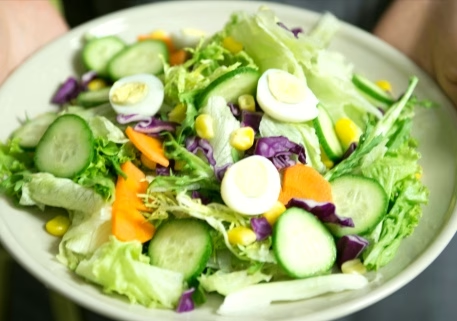A refreshing, sweet salad, enjoyed before or during meals, can whet your appetite and reduce greasiness. I’ve always wanted to make delicious salads at home, but I’ve been missing the secret. I want to create a salad dressing that’s both sweet and sour, with just the right amount of tang. It turns out there’s a specific ratio.
Besides leafy vegetables, you might have never thought you could make an omelette salad with eggs. Master the following key points for salad preparation and dressing to make your salad even more delicious.
Salad Making Methods
Regardless of the salad type, master these four principles to create a visually appealing and delicious salad. Soak leafy vegetables in water for a crispier texture.
Leafy vegetables have the crispest and most refreshing taste of any vegetable. Soak them in water before serving and let them rest for 10 minutes to restore their crispness.
Drain before serving.
Drain soaked vegetables in a vegetable spinner (or strainer) before applying salad dressing. Residual moisture can dilute the flavor of salad dressing, so be especially careful.
Use a small amount of salad dressing to mix.
Mix salad dressings often contain salt, so applying the dressing will dehydrate the vegetables due to osmotic pressure. To minimize flavor loss, be mindful of the amount of dressing used when mixing your salad.
Incorporate air into your salad mix.
Gently serving the salad is key to preserving the texture of the vegetables. When mixing, avoid pressing too hard; instead, gently lift the vegetables from the bottom of the bowl to incorporate air.
Salad Dressing Formula
Mastering the salad dressing formula will allow you to create a variety of flavors.
“Oil: Vinegar: Salt = 15:3:1.” Use a measuring spoon when measuring.
Substitute the desired amount into this formula to ensure success.
For example, to make 150ml of salad dressing, use 10 tablespoons of oil, 2 tablespoons of vinegar, and 2 teaspoons of salt.
Oil – 5 tablespoons
Olive oil, canola oil (or salad oil), and sesame oil. Use these three oils as a base for a basic salad dressing.
Vinegar – 1 tablespoon
You can use wine vinegar (red or white), rice vinegar, or citrus vinegar (lemon or orange, etc.), each resulting in a different flavor.
Salt – 1 teaspoon
It’s recommended to use natural salt, which is rich in minerals, for a smooth, non-pungent salty flavor.
Basic Salad Dressing Ⓐ (Canola Oil Base)
Ingredients and Instructions
Thickly combine 10 tablespoons canola oil (or salad oil), 2 tablespoons vinegar, and 2 teaspoons salt.
Basic Salad Dressing Ⓑ (Olive Oil Base)
Ingredients and Instructions
Thickly combine 10 tablespoons olive oil, 2 tablespoons vinegar, and 2 teaspoons salt.
Basic Salad Dressing Ⓒ (Sesame Oil Base)
Ingredients and Instructions
Thickly combine 10 tablespoons sesame oil, 2 tablespoons vinegar, and 2 teaspoons salt.
Using a basic salad dressing blended using the golden ratio, you can create a variety of salad variations. For example, using eggs as the main ingredient, you can make egg salad:
Egg Salad Recipe
Eggs can be made into omelets, scrambled eggs, soft-boiled eggs, and more, offering a wide variety of salad main dishes. Egg dishes are popular with both adults and children, making them perfect for breakfast.
The appeal of egg salad lies in the flexibility of adjusting the amount and flavor by adding other ingredients.
Even when ingredients with the same aroma, color, and umami-enhancing properties are used, the preparation method can vary depending on the intended use.
Main Dish
Ratio: 7
Eggs come in either white or brown varieties, and it doesn’t matter which type you use, as long as they’re fresh. Eggs made into omelets or scrambled eggs are more suitable for serving as a main dish.
Aroma/Color
Ratio: 2
Brightly colored and flavorful vegetables such as zucchini, broccoli, cauliflower, cucumbers, lettuce, and carrots; colorful vegetables such as tomatoes, cherry tomatoes, bell peppers, red onions, and mixed leaf lettuce.
Umami/Flavor Enhancement
Ratio: 1
Umami-rich ingredients such as prosciutto, bacon, and corned beef; seasonings that enhance the aroma of eggs such as curry powder, coarse black pepper, and yellow mustard; rich and mellow ingredients such as mozzarella, Parmesan, Japanese mayonnaise, and cream.
Omelette Egg Salad Recipe
Warm Egg Salad with Pickled Tomatoes
Ingredients and Instructions: Serves 2
Ratio: 7: 6 eggs
Ratio: 2: 6 cherry tomatoes (70g)
Ratio: 1: 100g mozzarella cheese
- Crack the eggs into a mixing bowl and mix well. Add approximately 1 teaspoon of salt. Remove the stems of the cherry tomatoes and cut them in half lengthwise. Add 1 tablespoon of Basic Salad Dressing B and mix well. Cut the mozzarella into 8 slices.
- Heat 1 1/2 tablespoons of EXV olive oil in a frying pan over medium heat. Pour the egg mixture in. Once the edges of the egg begin to form, use a silicone spatula to push the egg toward the center. Repeat this process until the egg mixture is semi-set and does not run even when the pan is tilted. Place the mozzarella cheese on the side closest to you, cover the pan, and steam for 1 minute.
- Open the pot, add the cherry tomatoes, and fold the outer omelet forward as shown. Transfer to a plate and sprinkle with pepper.
The 7:2:1 salad formula: Master the golden ratio of 6 ingredients x 9 salad dressings. By understanding the combination methods, you can create both cold and warm salads that rival those of famous restaurants.


Leave a Reply